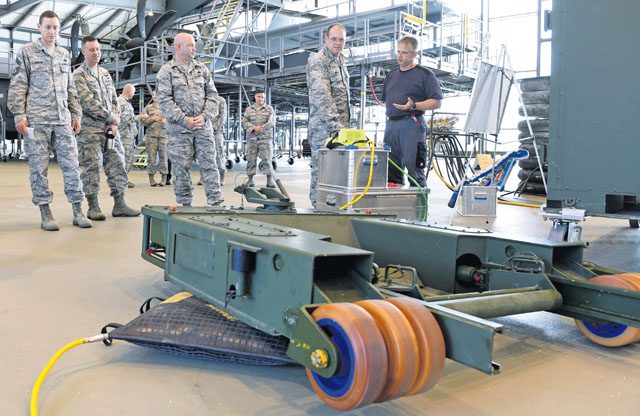
The Air Force functions like a complex machine made up of interlocking gears that keep the mission rolling. Every wheel is important with its specific function, but when one gear malfunctions, the whole mechanism suffers. The 86th Maintenance Group is an element of Ramstein that keeps the mission pushing forward.
“The military is an instrument of national power, and the Air Force is an incredibly flexible and responsive arm of that instrument,” said Col. Paul Filcek, 86 MXG commander. “Ramstein is the nerve center for Air Force operations in this hemisphere, and the 86 MXG is critical.”
The group supports European, Africa and central commands. It is home to the only tactical airlift maintenance organization, distinguished visitor airlift and 24/7 aeromedical evacuation operation in U.S. Air Forces in Europe. It is also the crashed, damaged and disabled aircraft recovery agent for all of Europe and operates the largest precision measurement equipment laboratory in the Air Force.
“Simply put, the 86 MXG provides jets and equipment that project airpower for almost the entire hemisphere,” Filcek said. “Maintainers are much more than mechanics and craftspeople, they are high-tech puzzle masters and extraordinary production orchestrators. A typical day for a maintainer involves a lot of problem solving by default.”
The group is broken into three sections: 86th Aircraft Maintenance Squadron, 86th Maintenance Squadron and the maintenance operations element. Within these are 12 flights and 18 sections comprised of more than 20 different Air Force specialty codes.
Approximately 1,000 Airmen and contractors fall under the 86 MXG, each section contributing to the overall mission. Sometimes juggling all of them can prove to be difficult.
“No day is the same,” said 1st Lt. Terry Hebert, 37th Aircraft Maintenance Unit assistant officer in charge. “This brings its own set of new and unique challenges, but to see our world class maintainers tackle each job encountered with pride and precision, there’s just no better feeling.”
The 86 AMXS performs maintenance for 14 C-130J Super Hercules, five C-21 Learjet, two C-37 Gulfstream V and a Boeing C-40 aircraft. They launch, recover, service, inspect and repair aircraft, both at Ramstein and on the road as flying crew chiefs.
“(Some may not realize) the amount of man hours it takes to put one C-130J in the air,” Hebert said. “On average, every time you see an aircraft in the air it takes 19 maintenance man hours to produce that one flight.”
The 86 MXS performs longer, regularly scheduled preventive aircraft inspections, nondestructive inspections for aircraft and equipment, aerospace ground equipment maintenance and distribution, backshop component testing and repair, and much more.
“Think of (the 86 AMXS) like a pit crew during a race and (the 86 MXS) as the repair garage after or before the race,” Filcek said. “But it is not that clear-cut. The 86 MXS has a very direct hand in daily sortie production and the 86 AMXS accomplishes very significant unscheduled repairs and maintenance. The overlap is synergistic by design.”
It is only when each gear within a machine is in its correct place and functioning properly that the mechanism can perform its job as a whole. The 86 MXG keeps Ramstein mission ready so when the time comes it can play its role in the large scale machine that is the Air Force.
“We are all one team at Ramstein,” Filcek said. “There is not another group in the Air Force I’d rather command, and I’m pretty sure every group commander here feels the very same way. Each group is critical, and each is as good as it gets. To all of Team Ramstein, let’s take care of each other every day, and let’s ‘hack the mish’ like no one else!”


